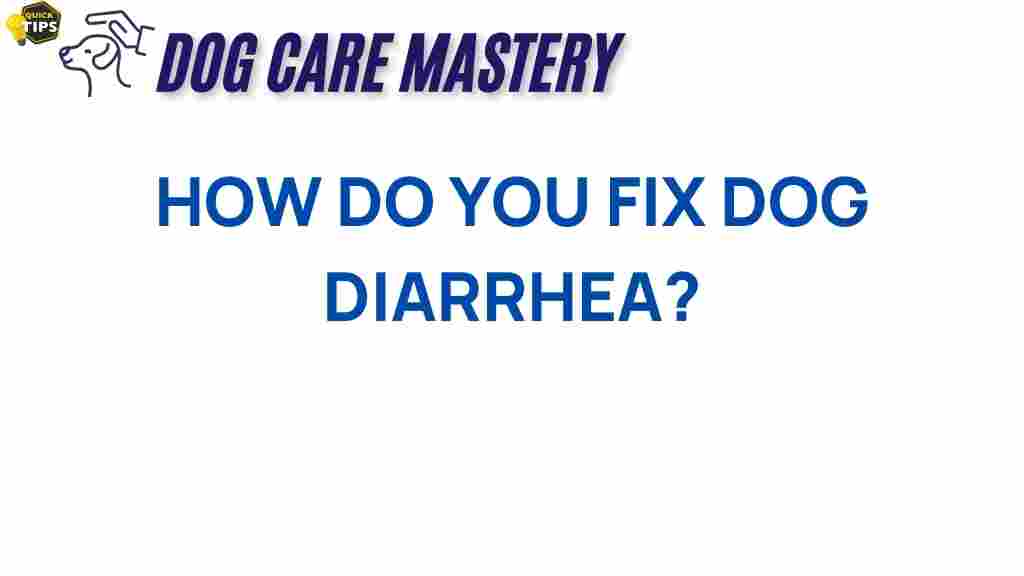Unraveling the Mystery: How to Fix Dog Diarrhea Effectively
Dog diarrhea is a common issue faced by many pet owners. It can be alarming to witness your beloved furry friend experiencing digestive distress. Understanding the causes and knowing how to effectively address dog diarrhea is essential for any responsible pet owner. In this article, we’ll explore the various aspects of dog diarrhea, from its causes to effective treatment methods.
Understanding Dog Diarrhea
Before diving into solutions, it’s crucial to understand what dog diarrhea is and why it occurs. Diarrhea in dogs is characterized by loose, watery stools, often accompanied by an urgency to relieve themselves. While occasional diarrhea is usually not a cause for concern, persistent diarrhea can lead to dehydration and other health complications.
Causes of Dog Diarrhea
Several factors can contribute to dog diarrhea. Some of the most common causes include:
- Dietary Changes: Sudden changes in diet or the introduction of new foods can upset a dog’s digestive system.
- Food Intolerance: Dogs can develop intolerances to specific ingredients, leading to gastrointestinal upset.
- Infections: Bacterial, viral, or parasitic infections can result in diarrhea.
- Medications: Certain medications may have side effects that include diarrhea.
- Stress: Just like humans, dogs can experience stress that affects their digestion.
Understanding the potential causes of dog diarrhea is the first step in determining how to address it effectively.
How to Fix Dog Diarrhea: Step-by-Step Process
When dealing with dog diarrhea, it’s essential to approach the situation methodically. Here’s a step-by-step guide to help you fix dog diarrhea effectively:
Step 1: Monitor Your Dog
Before taking any action, monitor your dog for other symptoms. Look for:
- Presence of blood in the stool
- Vomiting
- Lethargy
- Loss of appetite
- Signs of dehydration (dry gums, excessive thirst)
If you notice any of these symptoms, consult your veterinarian immediately.
Step 2: Temporarily Withhold Food
For mild cases of dog diarrhea, withholding food for 12-24 hours can give your dog’s digestive system a chance to recover. However, do ensure that your dog has access to fresh water to prevent dehydration.
Step 3: Introduce a Bland Diet
After the fasting period, introduce a bland diet to help soothe your dog’s digestive system. Consider the following options:
- Boiled Chicken and Rice: A classic combination that is easy on the stomach.
- Plain Pumpkin: Canned pumpkin (not the spiced pie filling) can help firm up stools.
- Plain Sweet Potatoes: These are gentle on the digestive tract and nutritious.
Feed small amounts of this bland diet for a few days until the diarrhea resolves.
Step 4: Gradually Reintroduce Regular Food
Once your dog’s stools have returned to normal, gradually reintroduce their regular food over the course of several days. This can help prevent a sudden return of diarrhea.
Step 5: Stay Hydrated
Ensure your dog stays hydrated. You can add electrolyte solutions designed for pets to their water to help replenish lost nutrients.
Troubleshooting Tips for Dog Diarrhea
If your dog’s diarrhea persists for more than a day or two, or if it worsens, it’s critical to seek veterinary care. Here are some troubleshooting tips:
- Check for Dietary Allergies: If the diarrhea returns after reintroducing regular food, consider potential food allergies or intolerances.
- Assess Environmental Factors: Look for any changes in your dog’s environment that might be causing stress or anxiety.
- Keep an Eye on Medications: If your dog is on medication, consult with your vet to see if it could be the cause of the diarrhea.
- Regular Vet Check-ups: Regular visits to the vet can help catch and prevent potential issues before they escalate.
By staying vigilant and responsive, you can help ensure your dog’s health and well-being.
When to See a Veterinarian
While many cases of dog diarrhea can be managed at home, there are instances when veterinary intervention is necessary. Consult your veterinarian if:
- Your dog’s diarrhea persists for more than 24 hours.
- You observe blood in the stool or black, tarry stools.
- Your dog is experiencing vomiting or severe lethargy.
- There are signs of dehydration.
- Your dog is very young, very old, or has pre-existing health conditions.
Preventing Dog Diarrhea
Prevention is always better than cure. Here are some effective strategies to help prevent dog diarrhea:
- Gradual Diet Changes: Always introduce new foods gradually to avoid upsetting your dog’s stomach.
- Regular Feeding Schedule: Maintain a consistent feeding schedule to promote digestive health.
- Quality Diet: Invest in high-quality dog food that meets your dog’s nutritional needs.
- Avoid Table Scraps: Human food can upset a dog’s stomach and lead to diarrhea.
- Regular Vet Visits: Schedule regular check-ups with your veterinarian to monitor your dog’s health.
Conclusion
Dog diarrhea can be concerning, but with the right knowledge and approach, you can effectively manage it. By understanding the causes, following a step-by-step treatment guide, and implementing preventive measures, you can help keep your furry friend healthy and happy.
Remember, if you ever feel uncertain or your dog’s condition worsens, don’t hesitate to reach out to your veterinarian for assistance. For more information on general dog health, check out this helpful resource.
Additionally, you can explore more about common canine issues and their solutions here.
This article is in the category Health and created by dogcaremastery Team
